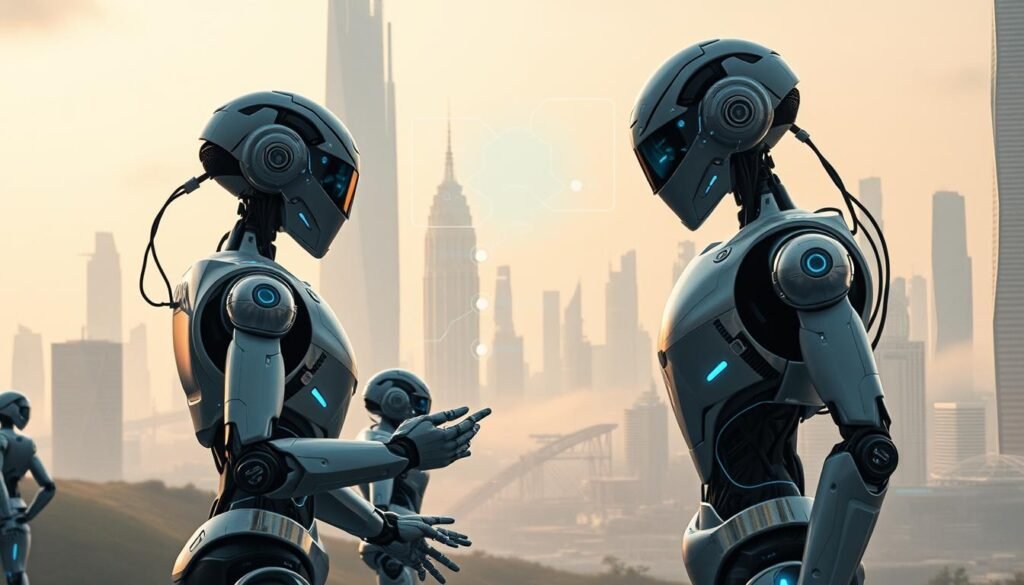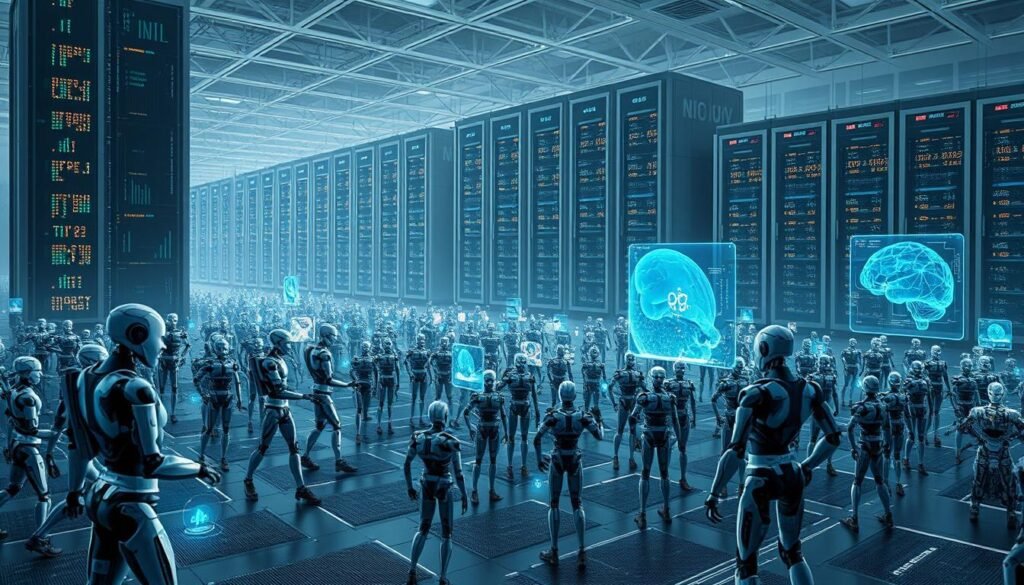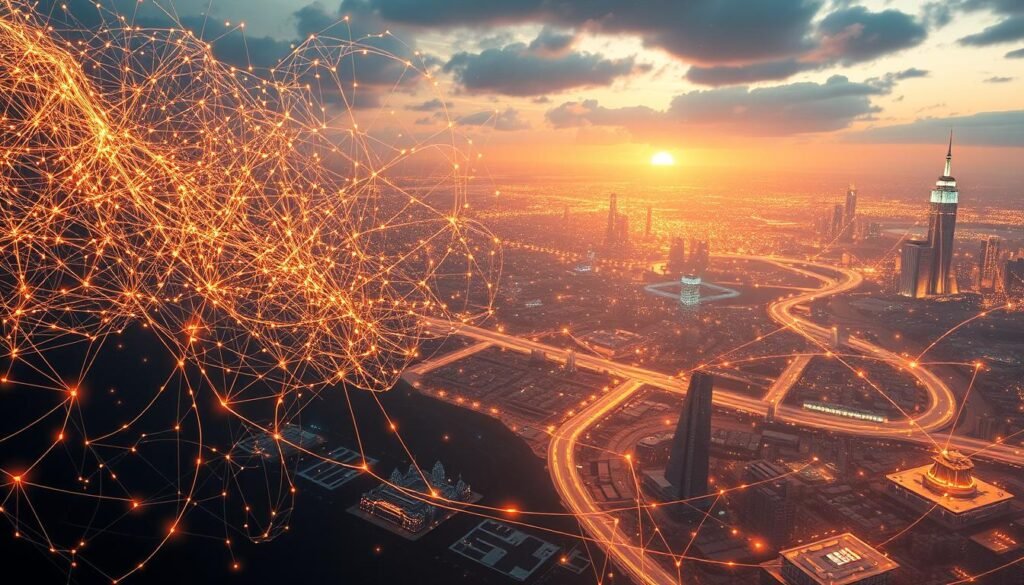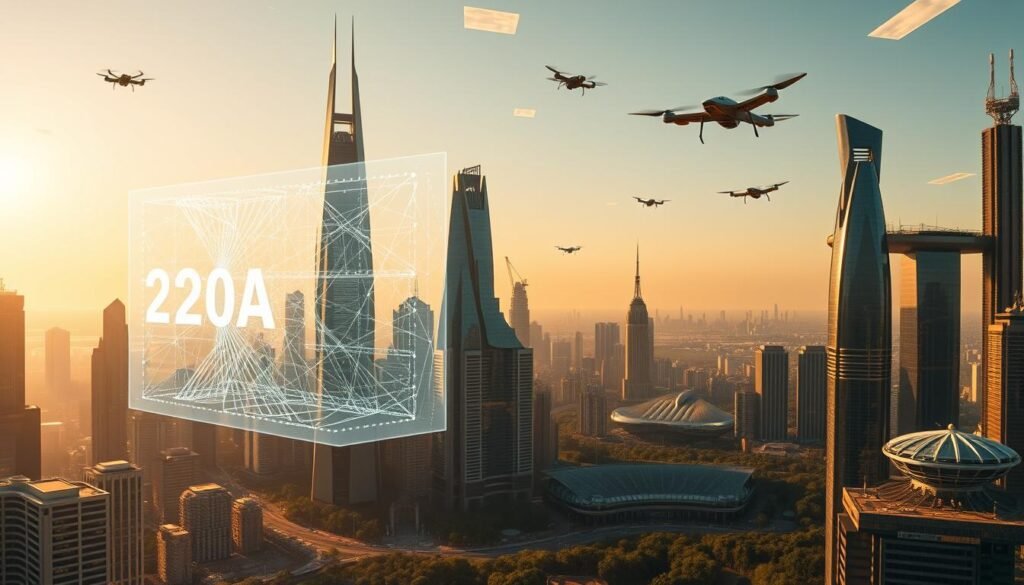AI Advancements are accelerating rapidly, and as we get closer to May 2025, the world of artificial intelligence is set for big changes. But what does the future hold for this fast-growing tech?
Artificial intelligence progress is expected to transform many industries, shaping the tech world in ways we can’t yet imagine.
The fast growth in AI technologies makes May 2025 a key time for groundbreaking innovations and industry-shifting breakthroughs.
Key Takeaways
- Significant transformations in artificial intelligence expected by May 2025
- Artificial intelligence progress to impact various industries
- Future technology trends to shape the technological landscape
- Rapid innovation in AI technologies anticipated
- May 2025 to be a landmark period for technological advancements
The Current State of AI in Early2025
The state of AI in early 2025 is a mix of new tech and its use in industries. AI is getting better, and it’s important to know what’s behind this growth. We also need to look at who’s leading the way in AI.
Foundational Technologies Driving Progress
Several key technologies are pushing AI forward in early 2025. Machine learning advancements are leading the charge. They help create smarter and more effective AI models.
The digital transformation forecast shows a big move towards AI solutions. Companies from all industries are using new AI tech to keep up. This change is happening everywhere, not just in tech companies.

Key Players and Market Leaders
The AI world is led by a few big names. Google, Microsoft, and Amazon are leading the AI charge. They’re working on new AI tech and offering AI solutions to businesses.
| Company | Key AI Contributions | Market Impact |
|---|---|---|
| Advanced AI algorithms, AI-powered search | Significant influence on AI research and development | |
| Microsoft | Azure AI, AI-driven productivity tools | Leader in enterprise AI solutions |
| Amazon | Alexa, AI-driven customer service | Dominant in AI-powered consumer technology |
These companies, along with others, are shaping AI’s future. Their work is not just making tech better. It’s also changing how businesses work and how they talk to customers.
AI Developments May2025: Comprehensive Forecast
May 2025 is expected to see big changes in AI, changing the tech world a lot. As we get closer to this date, many new AI technologies will change what AI can do.
Breakthrough Technologies on the Horizon
The future of AI will be shaped by predictive analytics. This will lead to cutting-edge AI applications in many fields. Here are some big changes we might see:
- Natural language processing will get better, making AI talk to us more like people.
- Computer vision will improve, helping AI see and understand images better.
- Reinforcement learning will get smarter, helping AI make decisions faster and better.
Dr. Andrew Ng says, “AI is like electricity. It will change many industries like electricity did.”
“AI has the potential to be a transformative technology, much like the steam engine or electricity.”

Anticipated Research Publications
May 2025 will also see a lot of important AI research. Some areas to watch include:
- Studies on AI ethics and bias, important for fair AI systems.
- Research on explainable AI (XAI), to make AI decisions clearer.
- Investigations into AI’s role in fighting climate change and sustainability.
These studies will improve AI’s tech and tackle big social issues with AI.
As AI keeps growing, May 2025 will mark a big step forward. It will bring us closer to more advanced and useful AI.
Quantum Computing Integration with AI
Quantum computing and AI are coming together to open new doors in machine learning and data handling. This mix is set to bring about big technological advancements.
Creating quantum machine learning algorithms is key to this partnership. These algorithms can handle big data faster than regular computers. This leads to big leaps in understanding language and making predictions.
Quantum Machine Learning Algorithms
Quantum machine learning uses quantum computing to make AI better. Quantum bits or qubits let these algorithms work on many things at once. This means they can process complex data quicker.
The main perks of quantum machine learning are:
- They can handle big data faster
- They’re more accurate at finding patterns and making predictions
- They can solve problems that regular computers can’t

Commercial Applications of Quantum AI
Quantum AI has many uses in business, from optimizing complex systems to boosting security. Finance, healthcare, and logistics will see big benefits from these new tools.
Some business uses include:
| Industry | Application |
|---|---|
| Finance | Portfolio optimization and risk analysis |
| Healthcare | Personalized medicine and drug discovery |
| Logistics | Supply chain optimization |
As machine learning updates keep getting better, quantum computing and AI will be crucial for the future of tech.
Next-Generation Large Language Models
The next big thing in AI is coming. It will change how we think about intelligent systems. These new models will make AI smarter and more like us.
Beyond GPT-6: New Architectures
The future of large language models goes beyond GPT-6. They will use innovative tech trends and AI breakthroughs. New neural networks will tackle complex tasks better.
Improving language understanding and common sense are key goals. Also, finding better ways to train these models is crucial.
Multimodal Capabilities Expansion
Next-generation models will also get better at handling different types of data. They will mix text, images, and more into one model.
This means users will get more interactive and detailed experiences. For example, a model could describe images or make images from text.
| Feature | Current Models | Next-Generation Models |
|---|---|---|
| Multimodal Capabilities | Limited to text or images | Integrated text, images, and potentially other data forms |
| Reasoning Ability | Basic common sense reasoning | Advanced common sense and nuanced understanding |
| Training Efficiency | Resource-intensive training | More efficient training methods with reduced resource requirements |

Healthcare Transformation Through AI
In May 2025, AI is set to change healthcare a lot. It will make medicine more precise and help find new drugs. AI will also improve how we care for patients and work in clinics.
Precision Medicine Advancements
Precision medicine will get a big boost from AI in May 2025. AI algorithms will look at lots of genetic data. This will help doctors create treatment plans that fit each patient perfectly.
- Genomic data analysis for targeted therapies
- Predictive modeling for disease prevention
- Personalized medicine approaches based on genetic profiles
AI-Driven Drug Discovery Breakthroughs
AI will also speed up finding new drugs in May 2025. AI systems will quickly find drug candidates and make clinical trials easier.
- AI-assisted compound screening
- Predictive analytics for clinical trial outcomes
- Optimization of drug development pipelines
Surgical and Diagnostic Innovations
Healthcare will also see new surgical and diagnostic tools. AI will make surgeries more precise and help find diseases early.
- AI-assisted robotic surgery
- Enhanced imaging techniques for early disease detection
- Real-time data analysis for informed decision-making
AI is changing healthcare a lot. We will see better patient care and more efficient clinics. May 2025 is a key time for these changes.
Autonomous Systems Evolution
AI advancements are pushing autonomous systems into new areas. They are changing industries and making cities more mobile. By May 2025, these systems will have grown a lot. This growth is thanks to machine learning advancements and a digital transformation forecast.
Self-Driving Vehicle Deployment Status
Self-driving cars are leading the way in autonomous systems. By early 2025, many companies have made big steps in using these cars on roads. Waymo has grown its service to new places, and Tesla keeps improving its Autopilot.
| Company | Deployment Status | Notable Features |
|---|---|---|
| Waymo | Expanded to new cities | Enhanced safety features |
| Tesla | Continued Autopilot updates | Advanced navigation system |
| Cruise | Testing in multiple locations | Integration with public transport |
Industrial Automation Leaps
Industrial automation is making big jumps thanks to innovation in AI technologies. Factories are getting smarter with AI robots and machines. This makes them more efficient and cheaper. Siemens and Rockwell Automation are leading this change.
Urban Mobility Transformation
Urban mobility is changing with the help of autonomous systems. Cities are using smart traffic systems and self-driving buses. This cuts down on traffic and makes air cleaner. It’s part of a bigger digital transformation forecast that includes AI in city infrastructure.
The growth of autonomous systems is about more than tech. It’s about making cities better and more efficient. As we move into 2025, we’ll see even more innovation in AI technologies leading these changes.
AI in Climate Science and Sustainability
AI is changing climate science and sustainability. It’s helping us understand and predict environmental changes better. This gives us new insights into our planet’s complex systems.
Environmental Monitoring Systems
AI is making environmental monitoring systems better. These systems use satellite data, IoT sensors, and machine learning algorithms. They track deforestation, ocean health, and extreme weather.
- Enhanced data collection through satellite imagery and IoT devices
- Improved predictive modeling using machine learning
- Better decision-making for conservation efforts
Energy Grid Optimization Technologies
AI is also key in making energy grids better. It analyzes how much energy we use and predicts demand. This helps grid operators manage energy better, cutting waste and improving reliability.
- Predictive maintenance for grid infrastructure
- Real-time energy demand forecasting
- Integration of renewable energy sources into the grid
AI in environmental monitoring and energy grid optimization is changing the game. It’s driving predictive analytics evolution and helping us tackle climate change.
Financial Services AI Revolution
The financial services sector is on the verge of a big change, thanks to AI. Financial institutions are using AI to change how they work, improve customer service, and reduce risks.
Algorithmic Trading Advancements
Algorithmic trading is key in today’s financial markets, with AI at its heart. AI helps analyze huge amounts of data, predict market trends, and make trades at the best times. This makes trading more efficient and profitable.
AI has made trading models smarter. Now, they can adjust to market changes quickly. For example, reinforcement learning lets algorithms learn from their actions and improve their strategies.
| Feature | Traditional Algorithmic Trading | AI-Enhanced Algorithmic Trading |
|---|---|---|
| Data Analysis | Limited to historical data | Real-time data analysis |
| Predictive Capability | Based on predefined models | Adaptive to changing market conditions |
| Execution Speed | Dependent on system performance | Optimized for maximum speed |
Personalized Banking Experiences
AI is changing how banks interact with customers. It uses natural language processing (NLP) and machine learning to offer personalized services and advice.
“The use of AI in banking is not just about improving efficiency; it’s about creating a more personalized and engaging experience for customers.” –
For instance, AI chatbots provide 24/7 support, answering questions and handling transactions. AI analytics also help banks understand what customers want, allowing them to tailor financial products.
Fraud Detection Systems
AI is making fraud detection better in finance. It uses machine learning to spot unusual patterns and flag fraud quickly, reducing false alarms and improving accuracy.
AI’s ability to learn from new data is a big plus in fraud detection. It keeps getting better at spotting fraud as tactics change.
- Real-time transaction monitoring
- Advanced anomaly detection
- Continuous learning and improvement
By using these advanced AI tools, financial institutions can work better, serve customers better, and stay ahead of threats. This is shaping the future of finance.
Creative Industries and Generative AI
Generative AI is changing the creative world. It’s how we make and enjoy content. Innovative tech trends are pushing the limits of what we can create.
Generative AI is making content creation tools better. These tools improve the quality and variety of what we see and hear. They also make creating content faster and easier.
Content Creation Tools Evolution
Content creation tools are getting smarter with generative AI. Creators can now make high-quality content with less effort. For example, AI can edit videos automatically, following certain styles.
Entertainment Industry Applications
The entertainment world is benefiting a lot from generative AI. It’s used for special effects in movies and personalized music playlists. AI breakthroughs are making entertainment more engaging and real for everyone.
Design and Architecture Innovations
Generative AI is also changing design and architecture. It helps architects and designers create complex ideas. This leads to new solutions in urban planning and building design.
As generative AI gets better, we’ll see more amazing uses in the creative world. The future of content, entertainment, and design is bright. AI breakthroughs are opening doors to a new era of creativity and innovation.
Edge AI and Decentralized Computing
Decentralized computing and Edge AI are changing industries by making devices smarter. They help process data faster and reduce delays. This is key for tasks that need quick decisions.
Machine learning updates are key to this change. They let devices run complex algorithms on their own. This means devices can act without needing the cloud.
On-Device Intelligence Capabilities
On-device intelligence lets devices make decisions on their own. They don’t need to talk to the cloud or a central server. This is important for things like self-driving cars and factory automation.
The innovation in AI technologies has made devices smarter. Now, they can do complex tasks quickly and accurately.
IoT Integration Advancements
Edge AI and IoT devices are changing how we use technology. They make IoT devices work better and faster. This is thanks to intelligence at the edge of the network.
This digital transformation forecast shows a big change towards smarter systems. As Edge AI grows, we’ll see more cool uses of IoT. This will change industries and make our lives better.
Ethical AI Frameworks and Governance
As AI grows, we need strong ethical rules and governance. AI systems must be clear, fair, and safe. This is crucial for their development and use.
Regulatory Developments Worldwide
Groups all over the world are making rules for AI. For example, the European Union’s AI Act wants to make sure AI is safe and respects people’s rights. In the United States, different agencies are working together to set guidelines for AI.
| Region | Regulatory Initiative | Key Focus |
|---|---|---|
| European Union | AI Act | Safety, transparency, and rights protection |
| United States | Federal and state guidelines | Ethical AI development and deployment |
| Asia | Varying national regulations | Data privacy and AI safety |
Industry Self-Regulation Initiatives
Companies are also setting their own rules for AI. Big tech and startups are making their own guidelines for ethical AI. This shows they care about using AI responsibly.
- Establishing ethics boards to oversee AI development
- Implementing transparent AI practices
- Conducting regular bias audits in AI systems
Bias Mitigation Technologies
Bias in AI is a big problem. It can cause unfair results and discrimination. Researchers are working on ways to fix this.
By using these new technologies, developers can make AI fairer. This leads to better results for everyone.
AI Accessibility and Democratization
Democratizing AI means making its benefits available to everyone. As AI technology gets better, it’s key to make it easy for more people to use. This includes those who aren’t tech experts and small businesses.
Low-Code and No-Code AI Platforms
Low-code and no-code AI platforms are making AI more accessible. These tools let users create and use AI solutions without needing to know how to code. Key features of these platforms include:
- Drag-and-drop interfaces for model building
- Pre-built templates for common AI tasks
- Automated machine learning (AutoML) capabilities
- Integration with existing business systems
Companies like Microsoft, Google, and Amazon are leading in this area. They offer platforms like Power Platform, AutoML, and SageMaker. These tools make AI development easier and drive innovation in many fields.
Educational Resources and Training
There’s also a growing need for education and training in AI. Initiatives like Andrew Ng’s AI Fund and Google’s TensorFlow tutorials help developers and businesses learn to use AI well.
| Resource | Description | Target Audience |
|---|---|---|
| Andrew Ng’s AI Courses | Comprehensive AI and machine learning courses | Professionals, Developers |
| Google’s TensorFlow Tutorials | Hands-on tutorials for TensorFlow framework | Developers, Researchers |
| Microsoft AI School | Learning resources for AI and machine learning | Developers, Businesses |
These educational resources are vital for closing the gap between AI technology and its use. As AI keeps evolving, the need for accessible education and training will grow even more.
Global AI Competition and Collaboration
The future of AI is shaped by both competition and collaboration worldwide. Nations and organizations are pouring money into AI research. This is changing the AI landscape fast.
Technological advancements and future technologies are leading this change. They affect many industries and societies globally. The right balance between competition and collaboration will guide AI’s future.
US-China AI Development Race
The AI race between the US and China is key in the global AI scene. Both countries are spending a lot on AI research, infrastructure, and talent.
| Country | AI Investment | Key Focus Areas |
|---|---|---|
| United States | $10 billion+ | Research, talent acquisition, infrastructure |
| China | $15 billion+ | AI for manufacturing, surveillance, smart cities |
International Research Partnerships
Even with competition, global research partnerships are growing. Teams from academia, industry, and governments are working together. They’re pushing AI forward and making new discoveries.
Emerging AI Hubs Worldwide
New AI hubs are popping up globally. Cities like London, Paris, and Singapore are becoming AI hotspots. They draw talent and investment from everywhere.
- London: Focus on AI for healthcare and finance
- Paris: Emphasis on AI ethics and regulation
- Singapore: AI for smart cities and urban planning
As the AI world keeps changing, it’s important to understand competition and collaboration. This knowledge is vital for everyone involved in AI.
AI Security and Cybersecurity Evolution
New tech trends are making AI security better, helping systems stay safe from cyber threats. As AI gets more common, we need stronger security to keep up.
Advancements in Threat Detection
Cyber threats are getting smarter, so we need better ways to find them. AI-driven threat detection uses machine learning to spot and stop security breaches fast. This makes companies safer.
These systems look at lots of data to find patterns that might mean trouble. This lets them act early to stop problems.
AI-Powered Defense Systems
AI is changing how we defend against cyber attacks. By using AI, companies can make dynamic security protocols that change with threats.
These AI systems can guess and stop attacks better than old security methods. They offer strong protection against new cyber dangers.
Privacy-Preserving AI Technologies
AI is used in many places, so keeping user data safe is key. Privacy-preserving AI technologies help keep data safe while still letting AI help us.
Things like federated learning and differential privacy are being looked at. They help keep data safe while still using AI for insights.
Workforce Transformation and AI
Machine learning is changing the future of work. AI is evolving, automating tasks and opening new opportunities for growth and innovation.
Emerging Job Categories
AI is creating new jobs in various industries. Roles like AI ethicist, data scientist, and AI trainer are becoming more common. These jobs need a deep understanding of AI and its applications.
Key Emerging Roles:
- AI and Machine Learning Engineers
- Data Analysts and Scientists
- AI Ethicists and Bias Mitigation Specialists
- Human-AI Collaboration Designers
Skill Requirements for the AI Economy
The AI economy needs a workforce with new skills. Professionals who can develop, implement, and work with AI are in demand. Skills in programming, data analysis, and critical thinking are key.
Critical Skills for the Future:
- Programming and Software Development
- Data Analysis and Interpretation
- Critical Thinking and Problem-Solving
- Adaptability and Continuous Learning
Human-AI Collaboration Models
AI is leading to new ways of working together with humans. These models aim to boost productivity by using the strengths of both humans and AI. The goal is to create systems that work well with human abilities.
The future of work will see humans and AI working together. This will lead to innovation in AI technologies and a more efficient workforce.
Conclusion: The Path Forward for AI Beyond May2025
As we near May2025, AI is set for big leaps. The expected ai developments may2025 will push artificial intelligence progress forward. This will shape future technology trends and machine learning advancements.
These changes will be key in guiding digital transformation forecast in many fields. The mix of AI with new tech will spark innovation in ai technologies. This will open up new chances for growth and progress.
The emerging tech landscape will see predictive analytics evolution and the use of cutting-edge ai applications. With tech advancing fast, we’ll see major leaps in future technologies and machine learning updates.
The future of AI looks bright, with innovative tech trends and ai breakthroughs leading to intelligent systems evolution. Beyond May2025, AI’s role in our world will grow. Keeping up with these advancements is vital for businesses, policymakers, and everyone.



